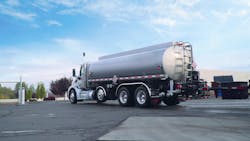Digital transformation has become critical in the fuel industry, especially now. Historically, the petroleum industry has dealt with more than its fair share of crises. From the 1970s oil crisis to the Saudi Aramco fire in September 2019, sudden, unpredictable disruptions of the fuel supply chain always have been an aspect of its volatile nature.
In 2020, the world witnessed an unprecedented decrease in fuel sales. On a global scale, there was a 35% decline in fuel demand in April 2020, but some regions have been majorly impacted with declines up to a staggering 65%, based on PDI’s COVID’s Effect on Fuel Demand report.
Although the signs of recovery allow for cautious optimism, oil companies, carriers and haulers need to keep a few key lessons in mind. Perhaps the most important lesson is the need for digital transformation to fundamentally change business performance.
The case for digital transformation
Historically, the logistics industry has faced some obstacles to improving supply chain visibility. Four areas top the list: information silos, disparate systems, manual processes and older technology. Combined, these limitations inhibit real-time visibility and, over time, degrade operations. A lack of automation and too many manual processes adds complexity, increases risk, and limits transparency among customers, carriers and suppliers. The opportunity costs to the business go beyond the bottom line and impact customer satisfaction as well.
That’s why it’s important to turn to a digital-first approach, seek to remove barriers that prevent information flow, and leverage technology that optimizes data captured throughout the supply chain. Each of these areas make up the very essence of digital transformation.
Today, achieving end-to-end visibility across the supply chain and logistics workflows are well within reach with a well-orchestrated digital transformation plan. Much debate surrounds the definition of digital transformation, and pundits still are figuring it out. However, most people agree with George Westerman, MIT principal research scientist, who said, “Digital transformation marks a radical rethinking of how an organization uses technology, people and processes to fundamentally change business performance.”
Although the debate about terminology and definitions is ongoing, one thing is clear: digital transformation is not coming; it is here. Operators of all sizes are beginning to reimagine the way they do business to survive. Here are few digital transformation trends we see on the horizon for the fuel logistics industry.
Rise of augmented intelligence
In 1984, Arnold Schwarzenegger popularized the phrase, “I’ll be back,” in his starring role as a cyborg assassin in “The Terminator.” The plot, which pitted the villainous Skynet-powered machines against humanity, left one of the most indelible impressions of artificial intelligence (AI) run amuck. The reality of AI, however, is much less sinister.
Since then, AI has been seamlessly integrated into our lives. It’s all around us. From email spam filters to navigational apps truckers regularly use, people interact with it every day. So, what’s next? In addition to the continuing adoption of AI, the industry likely will begin to see an increase in augmented intelligence. Augmented intelligence uses both human intelligence and AI capabilities. The key is to take advantage of typical human strengths—such as experience, flexibility and common sense—while using AI to automate repetitious and time-consuming tasks. Thus companies aren’t seeking to replace employees, they’re simply enhancing and complementing performance with more effective tools.
In the logistics industry, this enables businesses to further optimize their operations by improving productivity, saving money and reducing mistakes. In fact, Gartner estimates that augmented intelligence will create trillions of dollars in business value and increase worker productivity by several billion hours by 2021.
Increasing focus on supply chain resilience
It’s no secret that fuel logistics can be a complicated and volatile business, and that’s during a normal year. From an oil crisis whose effects are still ongoing to a global pandemic that continues to rage, 2020 has been anything but predictable.
On Jan. 20, 2020, the U.S. confirmed its first COVID-19 case in Washington state. During the early stages of the pandemic, economies around the world screeched to a halt, the stock market wiped out years of historic gains, and supply chains were interrupted as governments did their best to mitigate the fallout.
But it seems there’s at least one valuable lesson COVID-19 taught business owners everywhere: the need to invest in supply chain resiliency. According to a survey by the McKinsey Global Institute, 93% of CEO respondents said they were planning to take steps to mitigate future supply chain risk.
For fuel logistics companies, ensuring their supply chain is resilient will entail investing in digital capabilities that enable end-to-end supply chain visibility and the flexibility to react quickly to unexpected disruptions.
Turning big data into deeper insights
As regular consumers of business or technology media already know, it’s tough to go any length of time without seeing an article or other piece of content on the importance of data. Data is a big deal in general, but particularly for carriers and haulers. In an environment of stiff competition and thin margins, data is the key to maximizing profits, improving workforce productivity and increasing operational efficiency.
The International Data Corporation (IDC) predicts that connected Internet of Things (IoT) devices will generate 79.4 zettabytes of data in 2025. A few decades ago, most technology initiatives focused on producing data for all aspects of an operation. Today’s challenges have shifted toward capturing, storing and processing the data in a way that delivers real-time insights to influence business performance and enhance decision making.
IoT devices revolutionized the data capture process and are found throughout the fuel logistics industry today. From automatic tank gauges (ATG) to terminal automation systems (TAS), all the way to truck and trailer electronics, metering systems and even POS systems, digitally conscious operators benefit from access to various sources of data in the supply ecosystem.
For example, certain tools now can compile a data-based forecast to help carriers predict demand, ensuring they don’t run out of product or tie up valuable capital in excess inventory. So, what exactly does forecasting entail? It combines knowledge of the upper and lower limit of a tank with historical seasonal, holiday or special event (e.g. concerts) data to more accurately determine when a site will need fuel. Doing so empowers fuel haulers to fulfill customer expectations and remain profitable during times of wildly fluctuating demand.
Tapping into the cloud
It wasn’t so long ago that many business operators viewed a cloud-based infrastructure with a healthy dose of skepticism. Over the last decade, however, opinions began to shift, and the number of operations supported by purely on-premise solutions began to decline. In fact, by 2025, it’s estimated that 80% of enterprise workloads will be in the cloud.
Following a year where businesses had to support a fully connected but remote workforce, the trend is likely to only pick up steam. And for good reason. Cloud-based software enables fuel logistics companies to stay real-time and deliver continuity across borders and time zones. In addition, moving to the cloud cuts down on up-front and future costs from expensive hardware and long-term maintenance. The microservices and APIs that power these solutions also enable companies to easily scale and add services as they grow, which is particularly helpful for smaller carrier and hauler companies.
One of the main reasons, however, fuel logistics companies will likely increasingly transition to cloud-based infrastructure is the security they provide. A few months ago, VMWare released the results of a survey where 92% of U.S. respondents said the number of cyberattacks had increased in the last 12 months. Many of the attacks were related to COVID-19.
Securing sensitive data must be a priority for the fuel logistics industry. Encryption, log-in standards and role- or user-based security all are critical to minimizing the risk of a data breach. In addition, providers who offer cloud solutions often include monitoring services in the agreement that help companies guard against critical system errors and threats.
Begin the transformation
The challenges and complexities of the fuel logistics industry aren’t going away. There will always be disruptions and volatility, from natural disasters to once-in-a-century pandemics. In order to compete and win in today’s digital economy, companies must evolve. That evolution begins with digital transformation, and the result will be better productivity, adaptability, insights and visibility at every touchpoint in the operation.
Sid Gaitonde is the senior vice president and general manager for digital logistics solutions at PDI Software, a leader in enterprise management software for the convenience retail and petroleum wholesale markets that delivers solutions to connect intelligent business.
About the Author
Sid Gaitonde
Sid Gaitonde is the senior vice president and general manager for digital logistics solutions at PDI Software, a leader in enterprise management software for the convenience retail and petroleum wholesale markets that delivers solutions to connect intelligent business.

